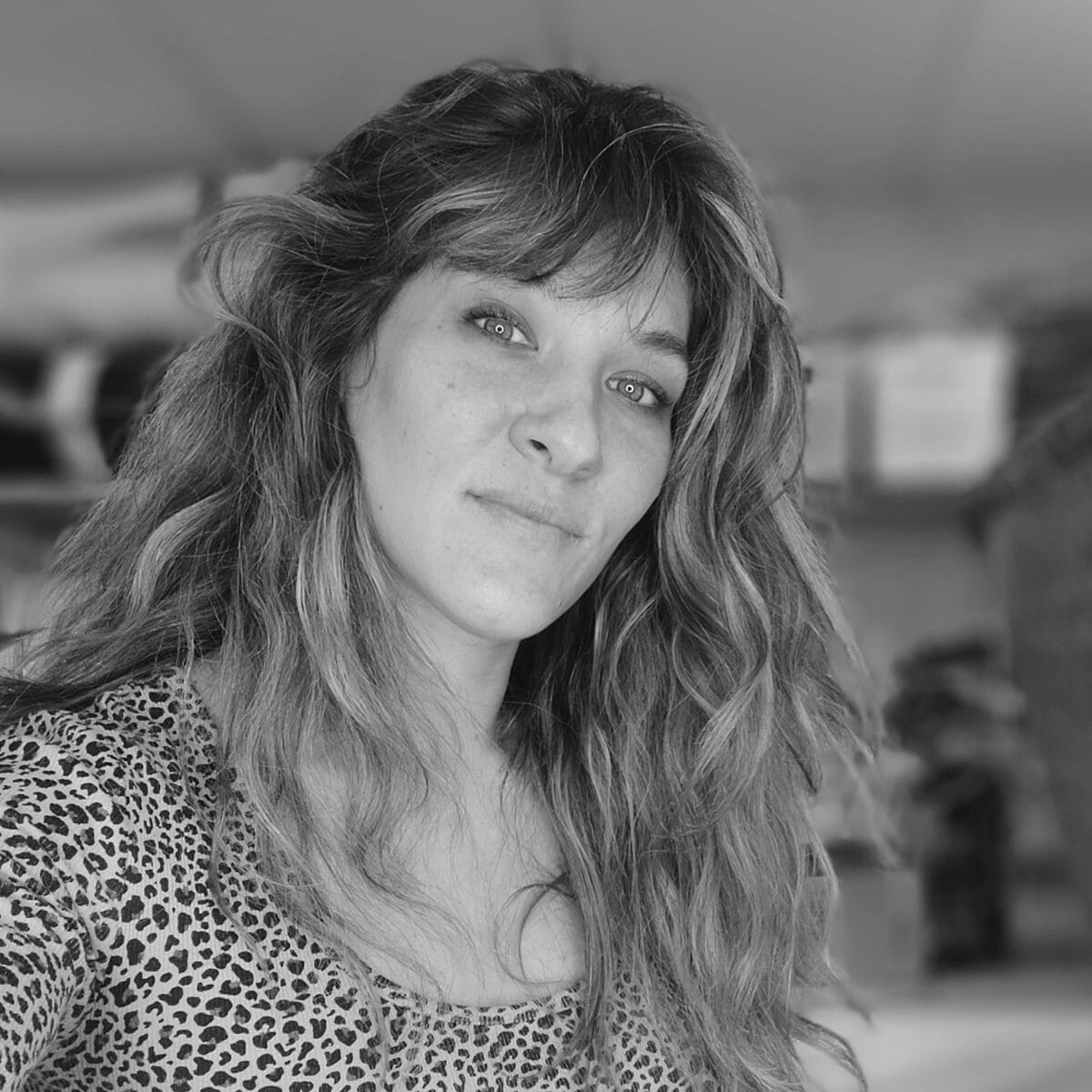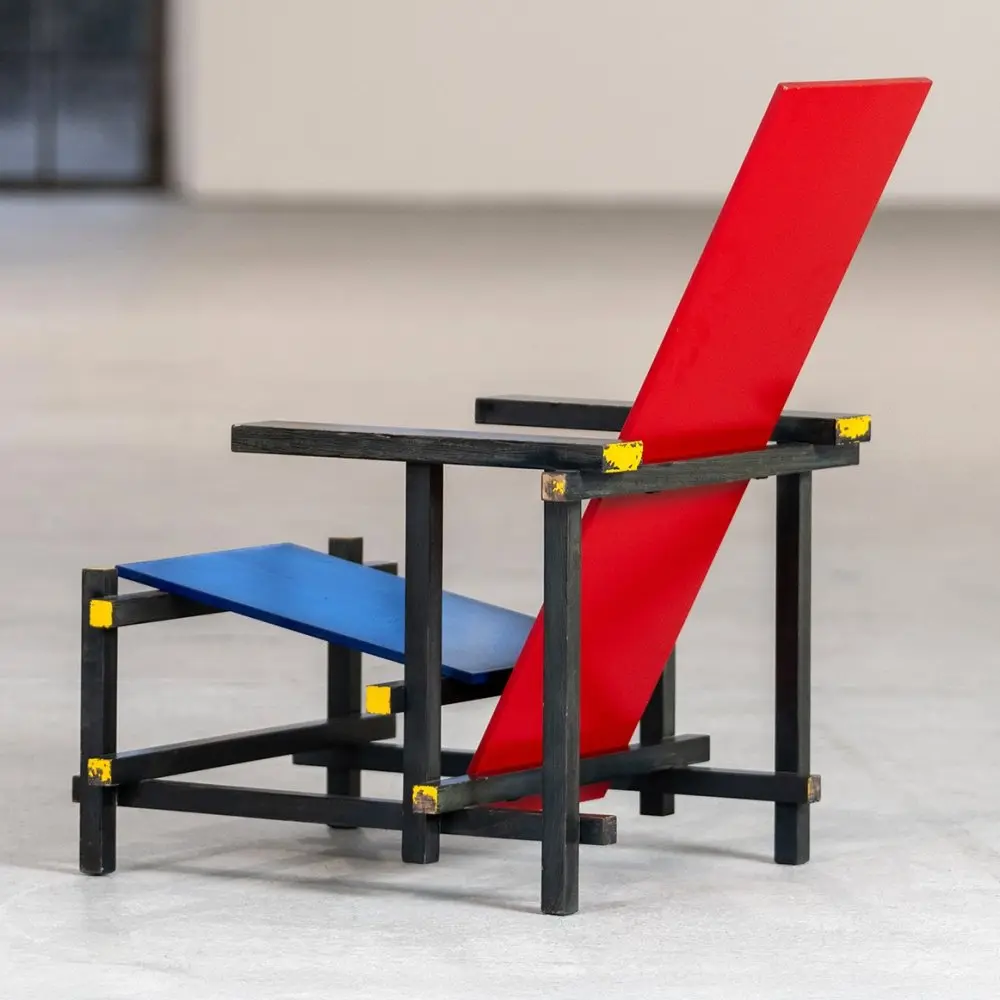Amsterdam, 1917. While Art Deco triumphed in Paris with its geometric ornaments and refined luxury, a group of Dutch artists and architects chose a radically opposite path. In a Europe torn apart by World War I, they founded a magazine that would give its name to one of the most radical movements of the 20th century. De Stijl – “The Style” in Dutch – was born from a visionary ambition: to create a universal language based on pure geometric abstraction, primary colors, and mathematical harmony.
Where Art Deco celebrated decoration and the preciousness of materials, De Stijl eliminated all ornament. Where Art Nouveau drew inspiration from the organic curves of nature, De Stijl imposed the absolute straight line. This movement, led by figures like Piet Mondrian, Theo van Doesburg, and Gerrit Rietveld, would profoundly influence modern architecture, design, and visual arts. More than a simple aesthetic, De Stijl proposed a utopian vision of a world rebuilt according to principles of order, clarity, and universality.
What is De Stijl
De Stijl is defined first by its formal radicalism. The movement rejected all reference to the natural world, all curves, all figurative representation. It was built on a minimal vocabulary: horizontal and vertical straight lines, primary colors (red, yellow, blue), non-colors (black, white, gray). This drastic reduction aimed to achieve a form of aesthetic universality, a visual language comprehensible to all, beyond cultural boundaries.
The movement fit into the broader context of European avant-gardes emerging in the early 20th century. Contemporary with the German Bauhaus and Russian Constructivism, De Stijl shared with them the conviction that art can and must transform society. But unlike these movements, De Stijl cultivated pure abstraction, refusing any compromise with functionality or industrial production in its early years.
The magazine De Stijl, published from 1917 to 1932, served as the movement’s manifesto. Theo van Doesburg, its founder and principal theorist, developed the concepts of neoplasticism – a term invented by Mondrian – and elementarism. These theories postulated that art must free itself from the particular to reach the universal, from the subjective to touch the objective. This philosophical ambition distinguished De Stijl in the history of modern design.
Historical & Cultural Context
The Netherlands experienced a particular situation during World War I: the country remained neutral, escaping the conflict’s destruction. This neutrality allowed artistic and intellectual life to develop while the rest of Europe was plunged into chaos. It was in this privileged context that De Stijl was born, carried by artists who observed the war with horror and dreamed of a new, rational, and harmonious world.
The movement drew its roots from several traditions. Dutch painting, with its tradition of sobriety and rigor inherited from the Golden Age masters, offered fertile ground. Calvinism, dominant in the Netherlands, also influenced the movement’s stripped-down aesthetic. But De Stijl also drew from the theosophical theories of Madame Blavatsky, very popular in Dutch intellectual circles. This mystical philosophy, which sought universal harmony behind appearances, particularly inspired Mondrian.
The influence of French Cubism was also felt. Mondrian stayed in Paris before the war and discovered the works of Picasso and Braque. But where Cubism deconstructed reality, De Stijl eliminated it completely. This radicalization of abstraction constituted the unique contribution of the Dutch movement to European avant-gardes.
World War I reinforced the conviction of De Stijl artists: individualism and nationalism had led Europe to catastrophe. Only a universal art, freed from cultural particularisms, could contribute to building a harmonious society. This utopian dimension ran through all the movement’s production and distinguished it from contemporary decorative currents like Art Deco.
Aesthetic Characteristics
The aesthetic of De Stijl is immediately recognizable by its absolute geometric rigor. Compositions were built exclusively on straight lines forming right angles. No diagonal, no curve disturbed this orthogonal order. This horizontal-vertical grid structured space according to precise mathematical proportions, creating a formal vocabulary of unprecedented radicalism.
Colors and Compositions
The chromatic palette was limited to three primary colors – red, yellow, blue – to which were added non-colors: black, white, and gray. This radical reduction was not arbitrary: primary colors were considered fundamental elements from which all other hues derived. They therefore possessed a universal status that secondary or tertiary colors did not have.
Color surfaces were organized according to rectangular surfaces of varied scales. The dynamic asymmetry of these compositions created visual balance despite the apparent simplicity of means. Mondrian spent years perfecting these arrangements, moving a line by a few millimeters to achieve perfect harmony. This obsession with precision contrasted sharply with the decorative exuberance of contemporary Art Deco.
Black played a structural role: black lines delimited colored zones and created the compositional grid. They were not simple outlines but architectural elements in their own right, building pictorial space as beams build a structure.
Theoretical Principles
Mondrian’s neoplasticism was based on several rigorous theoretical principles. First, the elimination of naturalism: art must no longer imitate nature but create a new reality, purely plastic. Then, reduction to essential elements: straight line, right angle, primary colors. Finally, the search for asymmetrical balance, more dynamic than traditional symmetry.
Van Doesburg later developed a variant he called elementarism, introducing the diagonal into compositions. This break with Mondrian orthodoxy caused a split within the movement in 1924, testimony to the doctrinal rigor that characterized De Stijl. These theoretical debates, published in the magazine, fueled discussions among European avant-gardes.
Creators & Key Figures
Piet Mondrian
Piet Mondrian (1872-1944) remained the tutelary figure of De Stijl. His artistic trajectory illustrated the progressive evolution toward pure abstraction. Trained in the Dutch landscape tradition, he discovered Cubism in Paris and progressively radicalized his approach. His famous compositions with red, yellow, and blue embodied the culmination of this quest for the universal.
Mondrian did not simply paint: he abundantly theorized his approach, publishing numerous texts in the De Stijl magazine. His obsessive search for perfect harmony led him to tirelessly rework his canvases, seeking the ideal balance between colored surfaces and black lines. Settling in New York during World War II, he would create his last works there, notably Broadway Boogie Woogie, where the influence of American jazz brought new dynamics to his formal vocabulary.
Theo van Doesburg
Theo van Doesburg (1883-1931), founder and animator of the De Stijl magazine, embodied the theoretical and militant dimension of the movement. A polymorphous artist – painter, architect, writer, typographer – he tirelessly spread De Stijl ideas throughout Europe. His lectures at the Bauhaus in Weimar in 1921-1922 profoundly influenced the German school, creating a decisive bridge between Dutch and German avant-gardes.
Van Doesburg progressively radicalized his positions, introducing the diagonal into his compositions from 1924, thus breaking with Mondrian orthodoxy. This evolution toward elementarism provoked the rupture with Mondrian but opened new paths for geometric abstraction. His Café Aubette in Strasbourg (1926-1928) remained one of the rare examples of interior architecture entirely designed according to De Stijl principles.
Gerrit Rietveld
Gerrit Rietveld (1888-1964) transposed De Stijl principles into the domain of design and architecture. His Red and Blue Chair (1918) became the icon of neoplastic furniture. Built from planks and orthogonal beams, painted in primary colors, it materialized Mondrian’s compositions in three-dimensional space.
The Schröder House in Utrecht (1924), Rietveld’s masterpiece, integrally applied De Stijl principles to architecture. Its open plans, mobile partitions, and asymmetrical facade composed of colored rectangular planes made it a built manifesto of neoplasticism. This achievement lastingly influenced international modern architecture and prefigured the spatial research of the modern movement.
Bart van der Leck
Bart van der Leck (1876-1958), painter and designer, participated in the movement’s early years. His compositions with colored geometric figures on a white background influenced the development of neoplastic vocabulary. Although he quickly left the group, his contribution to defining De Stijl aesthetic remained significant, particularly in applying neoplastic principles to textile design and posters.
Representative Architecture and Design
The Schröder House
The Schröder House (1924) by Gerrit Rietveld in Utrecht constituted the only architectural achievement entirely designed according to pure De Stijl principles. Inscribed on the UNESCO World Heritage list, this house revolutionized domestic living. Its flexible plans allowed space reconfiguration according to needs, anticipating contemporary concerns for adaptability.
The exterior was composed of rectangular planes – walls, balconies, awnings – that crossed without overlapping, creating a dynamic three-dimensional composition. Primary colors punctuated structural elements, while white dominated wall surfaces. This dissolution of the traditional architectural box announced modern architecture and directly influenced the development of the International Style.
Rietveld’s Furniture
The Red and Blue Chair (1918) transcended its utilitarian function to become habitable sculpture. Its structure of 13 beams and 2 planks orthogonally assembled without concealment revealed its construction. The red of the backrest and seat, the blue of the extremities, the black of the uprights, and the yellow of the tips created a chromatic composition that dialogued with Mondrian’s paintings.
Rietveld also created the Schröder table, the Berlin sideboard, and numerous other pieces that applied the same principles. This furniture, initially intended for a cultivated elite, lastingly influenced modern design and today enjoys numerous reissues by prestigious publishers like Cassina.
Café Aubette
The Café Aubette in Strasbourg (1926-1928), designed by Van Doesburg with Sophie Taeuber-Arp and Jean Arp, represented the most spectacular application of elementarism to interior architecture. Van Doesburg’s diagonal compositions covered walls, ceilings, and floors, creating a total spatial environment. Unfortunately demolished in the 1930s, this project was only partially reconstructed, but it remains a milestone in applying De Stijl principles to public space.
De Stijl and Its International Influence
Influence on the Bauhaus
De Stijl’s impact on the Bauhaus proved decisive. Van Doesburg’s lectures in Weimar in 1921-1922 upset students and certain teachers. Johannes Itten, influenced by De Stijl theories, revised his color teaching. Architect Walter Gropius himself integrated certain neoplastic principles into his practice.
This influence manifested in the Bauhaus’s evolution toward a more geometric and rational aesthetic from the mid-1920s. The typographic compositions of László Moholy-Nagy, the tubular furniture of Marcel Breuer, and the architecture of Dessau testified to this impregnation of De Stijl ideas. The Bauhaus would prolong and industrialize the formal research initiated by the Dutch movement.
International Diffusion
Beyond the Bauhaus, De Stijl influenced the entire Modern Movement in architecture. Le Corbusier, particularly in his purist villas of the 1920s, integrated principles of free plans and asymmetrical compositions. Mies van der Rohe developed an architecture of geometric purity directly inspired by neoplastic aesthetics. The International Style of the 1930s bore the indelible mark of De Stijl in its search for universality and rejection of ornament.
Modern graphic design also owed much to the Dutch movement. The asymmetrical typography developed by Van Doesburg and Piet Zwart, modular grids, and use of primary colors characterized 20th-century graphics. The Swiss school of graphic design, with figures like Josef Müller-Brockmann, directly prolonged De Stijl research in the postwar period.
Legacy & Reinterpretations
De Stijl’s legacy crossed the 20th century and still irrigates contemporary creation. Minimal art of the 1960s took up the reduction to essential elements and the compositional rigor of neoplasticism. Artists like Donald Judd, Sol LeWitt, and Dan Flavin explicitly acknowledged their debt to Mondrian and his companions, pushing the logic of simplification even further.
In architecture, the movement profoundly influenced the development of modernism. Curtain walls, open plans, and geometric abstraction became dominant characteristics of mid-century international architecture. This influence persists in contemporary architecture, particularly among architects like Richard Meier, whose white orthogonal compositions directly evoke De Stijl aesthetic.
Contemporary design regularly draws from the De Stijl repertoire. Creators among the great names of current design revisit neoplastic aesthetics, adapting them to contemporary materials and techniques. Konstantin Grcic, Jasper Morrison, and other contemporary minimalist designers prolong the quest for formal purity initiated by Rietveld.
In Popular Culture
De Stijl aesthetics deeply penetrated contemporary visual culture. Fashion designer Yves Saint Laurent dedicated a famous 1965 collection to it, the Mondrian dresses, which transposed the painter’s compositions onto clothing. This appropriation by high-end fashion testified to the iconic force of neoplastic vocabulary.
Advertising graphics and urban signage constantly borrow from De Stijl codes. Contemporary artists like Piet Parra reinterpret Dutch aesthetics in street art. Interface design and web design frequently use orthogonal grids and primary colors inherited from the movement. This diffusion into mass culture paradoxically confirms the movement’s universalist ambition, even if it often dilutes its original radicalism.
Current Market
Valuation and Collections
The art market for De Stijl works reaches dizzying heights. Mondrian’s paintings regularly sell for tens of millions of dollars at major international auctions. His compositions from the 1920s-1930s, the purest period of neoplasticism, constitute major heritage investments. In 2015, an abstract composition sold for $50.6 million at Christie’s.
Rietveld’s furniture also experiences exceptional valuation. Original pieces of the Red and Blue Chair reach several hundred thousand euros at auction sales. Contemporary reissues, notably produced by Cassina under license, range between 2,000 and 5,000 euros, allowing broader diffusion of De Stijl aesthetics among collectors and design enthusiasts.
Museums and Institutions
The main De Stijl collections are found at the Gemeentemuseum in The Hague, which houses the world’s most important Mondrian collection with nearly 300 works, and at the Centraal Museum in Utrecht, which houses the Schröder House and numerous Rietveld works. MoMA in New York also possesses major pieces from the movement, including several emblematic Mondrian compositions.
These institutions regularly organize exhibitions that reveal new aspects of the movement, keeping historical research alive. Academic interest in De Stijl remains undiminished, generating abundant scientific literature that continually enriches our understanding of the movement and its impact on modern art.
Conclusion
De Stijl embodied one of the most radical artistic adventures of the 20th century. Through its reduction to essential elements – straight line, right angle, primary colors – the movement created a visual language of exceptional power. This quest for the universal through geometric abstraction profoundly marked modern architecture, design, and visual arts, laying the foundations of international modernism.
Where contemporary Art Deco celebrated geometric ornament and material luxury, De Stijl advocated the total elimination of decoration. This opposition reflected two visions of the modern world: one seeking to reconcile artisanal tradition and industrial modernity, the other aspiring to a total break with the past. Paradoxically, both movements powerfully influenced the Bauhaus, which would synthesize their contributions in a vision integrating formal rigor and industrial production.
The movement’s utopian ambition – to transform society through art – certainly did not materialize. But its aesthetic influence far exceeded the Netherlands’ borders to irrigate all modern creation. From American minimalism to Scandinavian design, from the International Style to Swiss graphics, De Stijl’s legacy remains alive. Contemporary creators like Richard Meier in architecture, Konstantin Grcic in design, or Swiss school graphists directly prolong its research.
A century after its founding, De Stijl continues to fascinate through its absolute rigor and formal intransigence. In a world saturated with images, its radical simplicity offers a precious antidote. Mondrian’s compositions, Rietveld’s furniture, and the Schröder House architecture testify that a refined aesthetic can achieve intense beauty and spiritual depth. This movement paved the way for subsequent developments in abstraction and modern design, influencing generations of artists, architects, and designers.
This durability reveals an essential truth: reduction does not impoverish, it concentrates. By eliminating the superfluous, De Stijl touched the essential. Its message still resonates: order, clarity, and harmony remain fundamental human aspirations that art can express in its purest abstraction. This quest for the universal, so typical of the modernist spirit, continues to inspire those who believe in the transformative power of geometric beauty.

Digital entrepreneur and craft artisan, I use my unconventional background to share my vision of luxury design and interior decoration — one enriched by craftsmanship, history, and contemporary creation. Since 2012, I have been working daily in my workshop on the shores of Lake Annecy, creating bespoke interiors for discerning decorators and private clients.

